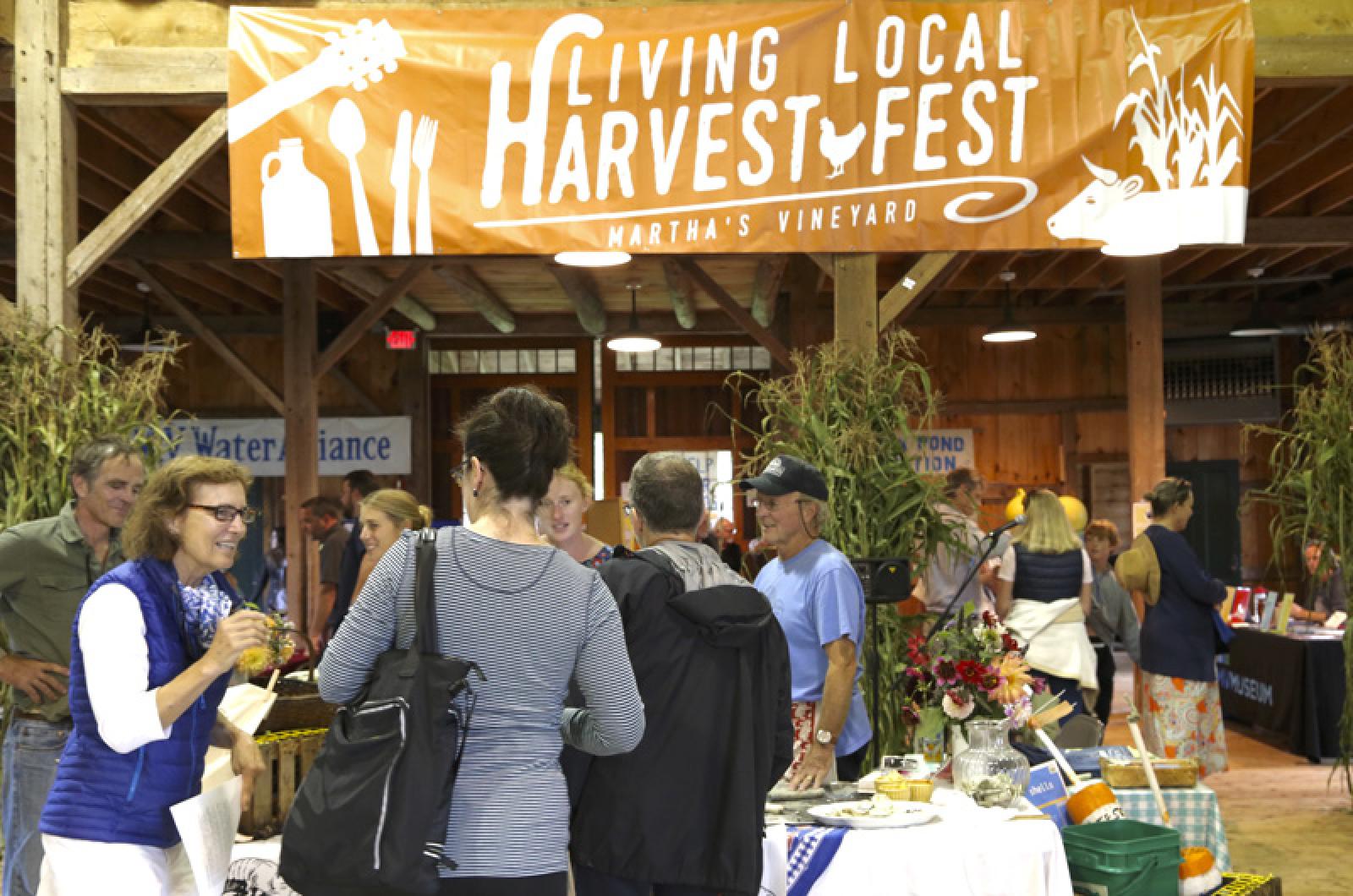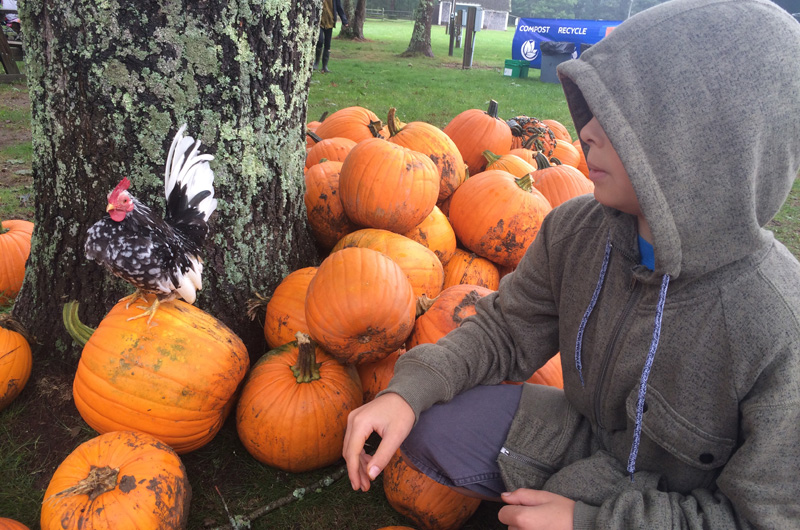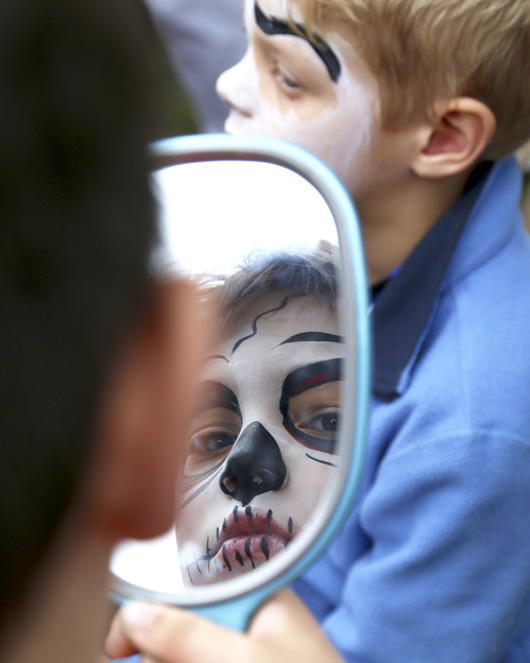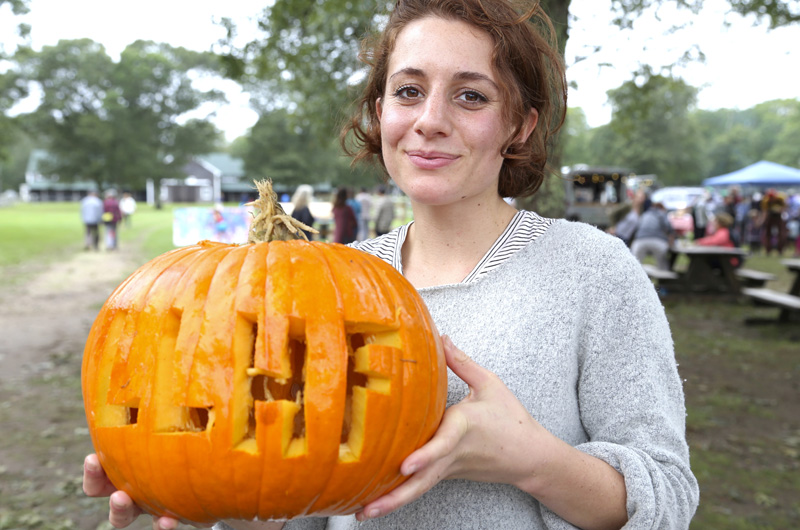Hundreds gathered Saturday for the annual Living Local Harvest Festival, a celebration of sustainable living held each fall on the grounds of the Agricultural Society in West Tisbury.
Green grass and orange pumpkins added color on Saturday as people relaxed at picnic tables and tapped their toes to the sounds of The Brazilian Jazz Trio, The Pickpocket Bluegrass Band and other local performers. Smoke rose from grills nearby and kids danced in the dirt.
Dozens of local groups hosted interactive exhibits inside the Agricultural Hall, where the smell of popcorn from Morning Glory Farm filled the air and the occasional alpaca drew a crowd.
The Martha’s Vineyard Fishermen’s Preservation Trust demonstrated the art of shucking and filleting, and kids made prints of black sea bass from the Menemsha Fish House. Trust director Shelley Edmundson estimated about 200 prints were created throughout the day. “And the same two fish,” she said.
Out on the grass, Featherstone Center for the Arts made its Living Local debut with a similar idea, as Morning Glory Farm vegetables became tools for printmaking. “I think the corn and the broccoli were the favorites,” said Featherstone art teacher Coral Shockey, demonstrating how an ear of corn could become a paint roller. A collaborative mural evolved throughout the day.
In another first for the festival, the Martha’s Vineyard Museum collected people’s stories about interesting Islanders, which it plans to add to its growing archive of oral histories, and perhaps incorporate into future exhibits.
Every picnic table in the grass was occupied in the afternoon, as visitors enjoyed a sampling of Vineyard cuisine. “They all kind of throw it down,” festival director Nevette Previd said of the eight food vendors, noting some newcomers this year, including Not Your Sugar Mamas and The Larder, both in Vineyard Haven. “They go super local and they get really inventive with their menus, which is exciting.”
Back inside, Marc Lavergne of Head High Kombucha in Edgartown doled out samples of his probiotic brew and uncapped brown bottles for his customers. When his 250 sample cups ran out, he borrowed more from the Chilmark Coffee Company, which also kept the energy flowing throughout the day.
Island Grown Initiative helped raise awareness of its many programs, including a collaboration this year with the Martha’s Vineyard Refuse District, which is accepting residential food waste, and added color with its new Mobile Market, a repurposed florist truck decorated with artwork by Islander Ashley Chase.
Earlier in the day, a new mini-guides series offered lessons on fermentation, Island reptiles, reusing garbage, worm composting and other topics.
Matthew Dix and Heidi Feldman enlightened visitors about the joys and sorrows of raising chickens, including how to avoid predators like raccoons and hawks. Too much stress can reduce egg production, Mr. Dix said. And chicken wire won’t always keep out raccoons, who can reach through the mesh.
“It’s not a pretty sight,” he said. For consistent egg-laying throughout the year, put a light bulb in the coop, said Ms. Feldman, noting the effect of reduced sunlight on the birds.
Warren Doty, at the shucking and filleting demonstrations, alerted visitors to the importance of returning shells to the water, rather then throwing them away. “That’s our tiny little way to affect ocean acidification,” he said. “If we at least keep the shells in the water, it adds calcium, and it’s a tiny help to keeping the pH adjusted right.”
The Martha’s Vineyard Shellfish Group contributed to a number of water-based presentations, showing how mussels can remove algae by filter feeding. Two tanks began the day a bright green tint, with one later becoming clear as mussels from Vineyard Haven fed on the algae.
“Someone will probably eat them tonight,” shellfish group special projects coordinator Emma Green-Beach said of the dozen or so mussels.
Picking up on last year’s theme of reduce-reuse-recycle, Nina Carter, who recently worked with Vineyard Conservation Society to establish an Islandwide ban on single use plastic bags, shared her experience in working toward a zero-plastic lifestyle. Her Facebook page, Plastic Free on MV, has documented her experiment, which began around 2013. “My point was just to show that it’s possible,” she said. “Everybody feels overwhelmed by it, but it’s just taking one thing at a time.”
Morning Glory Farm provided much of the raw material for the festival, including a large batch of pumpkins for carving and hay bales for a covered maze for kids to crawl through. Following tradition, the farm also brought out its wooden trebuchet (a medieval catapult device) and launched pumpkins into the distance.
As the sun went down, visitors enjoyed dinner by the Scottish Bakehouse, while the Flying Elbows called the turns of a contra dance.
“What’s so cool about the festival is that it really brings out multi-generations,” said Ms. Previd, taking a break as afternoon events wound down. “We try to be very conscious about programming that fits the personality of the Island. At the end of the day, it’s about education, and I hope you walk away maybe learning something about the community you didn’t know.”
“It’s super authentic,” she added of the festival and its reflection of an Island culture that some may overlook in the busy summers. “These are the people who make it tick.”











Comments (2)
Comments
Comment policy »